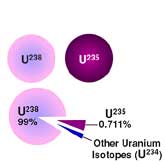What Is A Half-life?
 When isotopes break down, or decay, they usually split apart into two smaller atoms. Excess neutrons and protons are often sent flying off through space, taking the excess energy of the atoms with them. Interestingly, one form of radioactive decay product is the 'alpha particle', which is in reality just a helium atom with no electrons. Measurement of the amount of radiation coming from decaying isotopes is observed to be exponential. That is, it does not decrease at a constant (linear) rate, but at an ever-decreasing rate that depends upon the amount of material remaining. Materials that decompose in this way are said to have a 'half-life'. That doesn't mean that they exist in some weird pseudo-reality. What it does mean is that it takes that amount of time for half of the material present to break down.
When isotopes break down, or decay, they usually split apart into two smaller atoms. Excess neutrons and protons are often sent flying off through space, taking the excess energy of the atoms with them. Interestingly, one form of radioactive decay product is the 'alpha particle', which is in reality just a helium atom with no electrons. Measurement of the amount of radiation coming from decaying isotopes is observed to be exponential. That is, it does not decrease at a constant (linear) rate, but at an ever-decreasing rate that depends upon the amount of material remaining. Materials that decompose in this way are said to have a 'half-life'. That doesn't mean that they exist in some weird pseudo-reality. What it does mean is that it takes that amount of time for half of the material present to break down.
It is tempting to think that materials undergoing this decay process can only have two half-lives, in which the first half of the material decays followed by a similar period of time in which the second half of the material decays. This is not the case, however, because the rate at which decay occurs depends on the amount of material present. Thus, as the quantity of material present decreases, so does the actual rate at which the material decays.
In the first half-life period, one half of the original quantity of material decays and one half remains. During the second half-life period, one half of the remaining half decays, leaving one quarter of the original amount. After a third half-life period, one eighth of the original amount of material remains, and so on. In general mathematical terms, if the number of half-life periods is represented by 'n', and the original quantity of material is represented by 'x', then the amount of original material remaining at the end of that time is given by - M = (x/2) ^n, or (x/2 ^n)
About the Author
Richard M J Renneboog, MS
 Richard M. J. Renneboog is an independent private technical consultant and writer in both chemical and computer applications. Endeavors have included preparation of scripts for instructional and promotional video, corporate website design, curriculum development for training in advanced composites technology, and development.
Richard M. J. Renneboog is an independent private technical consultant and writer in both chemical and computer applications. Endeavors have included preparation of scripts for instructional and promotional video, corporate website design, curriculum development for training in advanced composites technology, and development.


